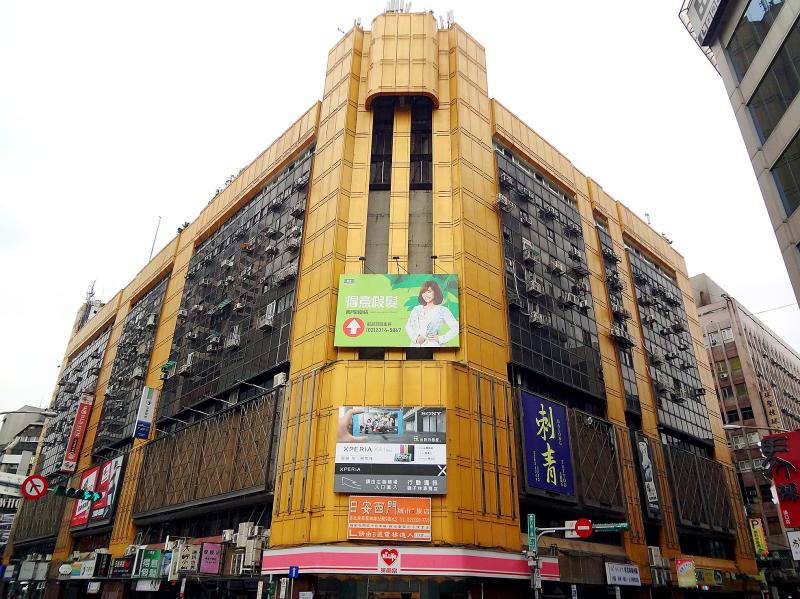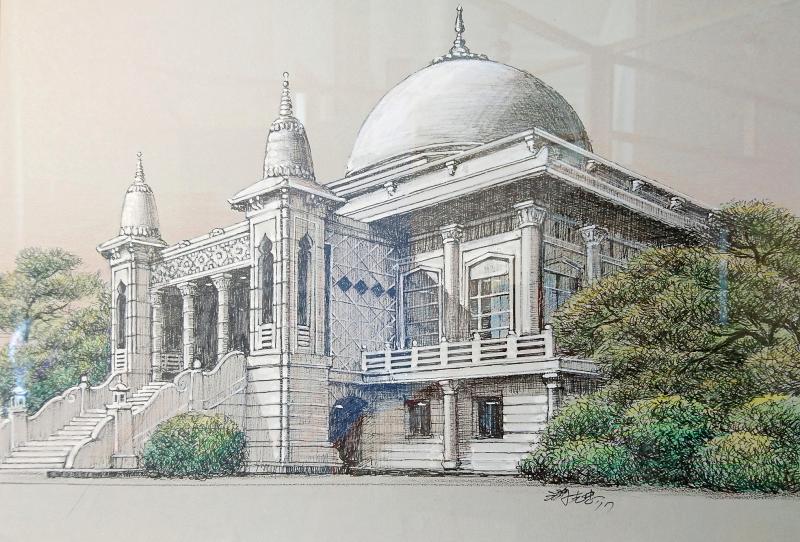March 15 to March 21
Although it is often mentioned among Taipei’s most haunted places, the Shizilin Commercial Building (獅子林大樓) was touted as the city’s hippest spot when it was completed in 1976.
The 10-story structure in Ximending (西門町) was unusually tall for those days, setting the standard for modern shopping malls with 300 stores, three movie theaters, a food court and high-end restaurants. Its faded, yellow exterior looks quite garish today, but in 1977 the design won first place in a national architectural competition. Despite a murder happening there in 1979, the building got even fancier on March 15, 1980 when it unveiled the nation’s largest rooftop amusement park.

Photo courtesy of Wikimedia Commons
There was little concept of cultural preservation back then, and few seemed to mind that developers razed a beautiful Indian-style Buddhist temple (the Taiwan branch of Japan’s famous Higashi Honganji) to make way for the mall. The temple had long ceased to be a place of worship by then, and until 1967 it was used by the Taiwan Garrison Command as a detention and interrogation center, mostly for political prisoners. The atrocities that took place there, in addition to several killings and accidents in the modern era, contribute to its spooky reputation.
The building’s fortunes didn’t last long. It was plagued with scandals and incidents and at one point was known as a hotbed for illicit activities and a gathering spot for delinquents. It still operates today as a shell of its former self, although Shin Kong Cinemas on the fourth and fifth floors is a popular screening spot for film festivals.
PALACE OF HELL

Photo: Hung Jui-chin, Taipei Times
Those familiar with Taipei’s historic buildings should notice that there’s also a Nishi Honganji in Ximending (nishi means west in Japanese, higashi means east). The west temple was also used as a prison at one point, and was fortunately restored and turned into a park.
The temples belonged to the two main sects of Japan’s Jodo Shinshu school of Buddhism (also known as Shin Buddhism), which split in 1602. Each sect constructed headquarters in Taipei to spread their beliefs during Japanese rule. The first iteration of Higashi Honganji lasted just two years, burning down in 1930. The classical Indian-style structure, rarely seen in Taiwan, was erected in its place in 1936.
The Chinese Nationalist Party (KMT) claimed the temple as “enemy property” upon its arrival in Taiwan in 1945. It was given to the military a year later, who turned it into a terrifying detention center that was dubbed the “palace of hell.”
The building is listed on the National Human Rights Museum’s “historical sites of injustice” Web site, where it details the horrific conditions with testimonies from former prisoners.
Aside from the solitary chambers, about 20 people were crammed into a 10m2 space that was infested with bugs and other pests. They showered once a week, had no toiletries or toothbrushes and the lights were never turned off, causing many to lose their sense of time. The cellmates shared a single chamber pot that was placed near the door and only emptied once a day, and the halls reeked horribly.
Former prisoner Huang Shih-kuei (黃石貴) recalls that guards tortured him severely during interrogations before even asking any questions, rendering him unable to walk after each session. Lu Chao-lin (盧兆麟) was tied to a torture rack while being waterboarded and electrocuted. He was denied sleep and water during his lengthy sessions.
SELLING THE TEMPLE
Kimimasa Matsukane writes in the study, “The Taipei Branch of Shin Buddhism’s Otani Sect After the War,” (referring to the temple’s official name) that the Taiwan Provincial Taoist Association (台灣省道教會) wanted the temple for their headquarters. As early as 1959 it had asked the government for the building. The request essentially stated that since Shandao Temple (originally another Jodo Shinshu temple) was given to the Buddhist Association after the war, their Taoist counterparts should have one too.
The association made the puzzling argument that Higashi Honganji was a suitable home since Shintoism originated from Taoism, enabling the government to simply reject their request on grounds that the temple was actually Buddhist.
The truth is that the government already had plans for the temple: the following year, it announced a five-year plan to relocate Taiwan Garrison Command structures out of downtown Taipei. The move would be funded by selling the land.
When they put the temple on the market in 1965, the Buddhist Association strongly objected, stating that the military was merely borrowing the building and that it should belong to them. At this time, the military also occupied parts of Shandao Temple.
After two years of arguing, the government offered to partially fund the association’s guesthouse for foreign visitors, as well as entirely remove its military presence from Shandao Temple. The association accepted. As for the Taoists, the transcript from a government meeting over the issue states that “they can be ignored.”
But the problems continued. In late 1967, the Japanese embassy lodged a complaint, arguing that per the post-war treaties that the two sides signed, the KMT could not sell any former Japanese property that was “purely used for religious or charitable purposes.”
The government dug up evidence that the Japanese used it as a secret service base during World War II, and finally, they were able to sell it.
Taiwan in Time, a column about Taiwan’s history that is published every Sunday, spotlights important or interesting events around the nation that either have anniversaries this week or are tied to current events.

In 1990, Amy Chen (陳怡美) was beginning third grade in Calhoun County, Texas, as the youngest of six and the only one in her family of Taiwanese immigrants to be born in the US. She recalls, “my father gave me a stack of typed manuscript pages and a pen and asked me to find typos, missing punctuation, and extra spaces.” The manuscript was for an English-learning book to be sold in Taiwan. “I was copy editing as a child,” she says. Now a 42-year-old freelance writer in Santa Barbara, California, Amy Chen has only recently realized that her father, Chen Po-jung (陳伯榕), who

Famed Chinese demographer Yi Fuxian (易富賢) recently wrote for The Diplomat on the effects of a cross-strait war on demography. He contended that one way to deter the People’s Republic of China (PRC) is by putting the demographic issue front and center — last year total births in the PRC, he said, receded to levels not seen since 1762. Yi observes that Taiwan’s current fertility rate is already lower than Ukraine’s — a nation at war that is refusing to send its young into battle — and that its “demographic crisis suggests that Taiwan’s technological importance will rapidly decline, and

For anyone on board the train looking out the window, it must have been a strange sight. The same foreigner stood outside waving at them four different times within ten minutes, three times on the left and once on the right, his face getting redder and sweatier each time. At this unique location, it’s actually possible to beat the train up the mountain on foot, though only with extreme effort. For the average hiker, the Dulishan Trail is still a great place to get some exercise and see the train — at least once — as it makes its way

When nature calls, Masana Izawa has followed the same routine for more than 50 years: heading out to the woods in Japan, dropping his pants and doing as bears do. “We survive by eating other living things. But you can give faeces back to nature so that organisms in the soil can decompose them,” the 74-year-old said. “This means you are giving life back. What could be a more sublime act?” “Fundo-shi” (“poop-soil master”) Izawa is something of a celebrity in Japan, publishing books, delivering lectures and appearing in a documentary. People flock to his “Poopland” and centuries-old wooden “Fundo-an” (“poop-soil house”) in